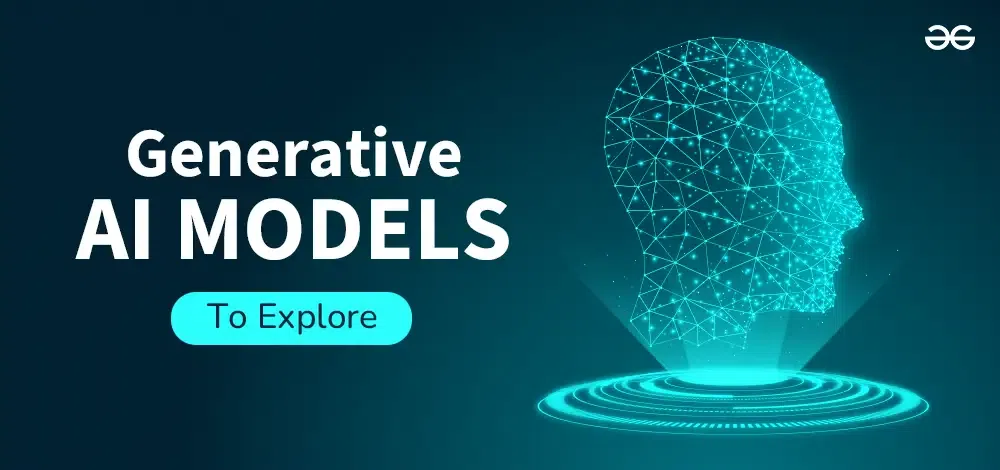Generative AI models have become potent instruments in the rapidly changing field of artificial intelligence, capable of producing original texts, visuals, and even whole stories. By 2024, generative AI will have advanced to never-before-seen levels thanks to a variety of models that are pushing the envelope in terms of originality and inventiveness.
These Generative AI Models demonstrate the breadth and depth of applications for Generative AI, ranging from language production to image synthesis. While some models are quite good at producing text that seems human, others produce realistic and beautiful visuals. Every model offers a different set of advantages and a window into the seemingly endless possibilities of AI-driven creation.
In this article, we’ll be looking into 9 distinct AI generative, segmented into Text, Image, and Code generative AIs. Before getting into the Top generative AI models, let’s first understand in brief what is generative AI.
What is Generative AI?
A family of artificial intelligence systems known as “generative AI” is able to produce new content, including text, images, audio, and even video, that resembles or imitates the data it has been trained on. Large datasets are used to teach these systems patterns and structures, which are then used to generate new examples that adhere to the same patterns.
To produce this information, generative AI frequently makes use of neural network techniques, namely generative adversarial networks (GANs) or variational autoencoders (VAEs). For example, GANs are made up of two neural networks: a discriminator and a generator.
Applications of Generative AI
Generative AI may be used to create realistic visuals, write prose that sounds human, compose music, produce artificial voices, and much more. This quickly developing sector offers a wide range of innovative and useful applications.
Top Generative AI Models to Explore.
We have categorized these Generative AI Models into three main segments: Text Generative AI, Image Generative AI, and Code Generative AI. Each segment represents a unique approach to generative AI, with models tailored to specific tasks and industries. By exploring these categories, we can gain a deeper understanding of the diverse applications and capabilities of generative AI in 2024.
Text Generative AI
Let’s begin with the top Text Generative AI models of 2024, which can be very useful whether you’re a designer, developer, or from any other domain.
1. CTRL (Conditional Transformer Language Model)
Salesforce Research created the Conditional Transformer Language Model, or CTRL. The Transformer design, a kind of neural network architecture that has shown efficaciousness for a variety of natural language processing applications, serves as the foundation for the CTRL model.
The capacity to condition the language model on particular control codes is the main breakthrough brought about by CTRL. With the help of these control codes, users can direct text generation toward specific topics, styles, or tones. CTRL is a conditional language model because of this conditioning feature, which allows it to produce text in response to predefined prompts and constraints.
Examples: In response to user commands, CTRL can produce text in particular styles or tones.
Applications
- Creative writing
- Content customization
- Generating text with specific attributes.
Benefits: Offers flexibility in terms of the generated text’s style and tone, making it appropriate for a range of artistic uses.
Key Features
- Control Codes: CTRL adds control codes to modify the language model’s output.
- Large-Scale Training: Like many state-of-the-art language models, CTRL benefits from large-scale pre-training on diverse datasets.
- Fine-Tuning: CTRL can be adjusted to fit certain tasks or domains by using specialized datasets.
- Customization: To accomplish various goals for language production, users can alter the control codes.
2. Generative Pre-Trained Transformer 3 (GPT-3)
OpenAI’s Pre-trained Transformer 3 (GPT-3) is a cutting-edge language model. Continuing from the success of GPT and GPT-2, it is the third version of the GPT series. The Transformer design is used by the potent autoregressive language model GPT-3.
Examples: Expected to do better than expected in problems involving the creation of natural language.
Applications: Wide-ranging uses in the production and comprehension of natural language.
Advantages: Enhanced efficiency and possible innovations in language modeling.
Key Features
- Prompt Engineering: The selection of prompts can affect how the GPT-3 behaves.
- Learning in Two Steps: GPT-3 exhibits the capacity to carry out two-step and zero-shot learning.
- Scale: The unparalleled scale of GPT-3 is one of its most remarkable characteristics.
3. Text-To-Text Transfer Transformer (T5)
In a work titled “Exploring the Limits of Transfer Learning with a Unified Text-to-Text Transformer” by Colin Raffel et al., Google researchers presented the flexible Text-To-Text Transfer Transformer (T5) language model architecture. T5’s central tenet is to formulate all-natural language processing (NLP) jobs as text-to-text issues, in which text strings are used for both input and output. This makes it possible to address different NLP jobs in a uniform and adaptable way.
Examples: T5 is well suited for a variety of tasks, including question-answering, translation, and summarization.
Applications
- Text summarization
- Language Translation
- Question answering, and other natural language understanding tasks.
Benefits: The training process for multiple NLP applications is made simpler by the unifying text-to-text architecture, making it easier to adjust to different jobs.
Key Features
- Unified Framework: T5 proposes a unified framework for various NLP tasks, including text classification, translation, summarisation, and question answering, among others.
- Text Generation and Compression: T5 can be used for both text generation and compression tasks.
- Pre-training and Fine-tuning: Like many other successful language models, T5 undergoes a pre-training phase on a large and diverse dataset.
Image Generative AI
Moving further in this article now let’s have a look at some amazing Image generative AI models that are popular to be used in 2024.
1. StyleGAN (Style Generative Adversarial Network)
A generative model architecture called StyleGAN (Style Generative Adversarial Network) was created specifically for the purpose of image synthesis.
An upgrade to the original GAN (Generative Adversarial Network) architecture, StyleGAN is renowned for producing a wide range of realistic and high-quality synthetic images.
Examples: With a high degree of diversity and inventiveness, StyleGAN is renowned for producing photorealistic faces and photos.
Applications
- Deepfake production
- Virtual fashion design
- Artistic image generating, and other creative applications.
Benefits: Generates realistic details in high-resolution, aesthetically pleasing photographs.
Key Features
- Generative Adversarial Network (GAN): StyleGAN is built upon the GAN framework, which consists of a generator and a discriminator.
- Open Source Implementation: NVIDIA released the source code for StyleGAN, making it available to the research and developer community.
- Application to Faces and Art: While StyleGAN is a general-purpose generative model, it gained significant attention for its ability to generate highly realistic faces.
2. Pix2Pix (Image-to-Image Translation with Conditional Adversarial Networks)
“Image-to-Image Translation with Conditional Adversarial Networks,” or Pix2Pix, is a deep learning model that was developed specifically for the purpose of translating images.
Numerous tasks, like converting black-and-white photos into color and satellite images into maps, have been accomplished with this paradigm.
Examples: Turning black and white photos to color and satellite images to maps.
Applications
- Colorisation of images
- Creative style transfer
- Medical picture segmentation.
Advantages: Conditional picture generation is helpful in some situations when input-output correlations are established.
Key Features
- Generative Adversarial Network (GAN): StyleGAN is built upon the GAN framework, which consists of a generator and a discriminator.
- Open Source Implementation: NVIDIA released the source code for StyleGAN, making it available to the research and developer community.
- Application to Faces and Art: While StyleGAN is a general-purpose generative model, it gained significant attention for its ability to generate highly realistic faces.
3. DeepDream
Google created DeepDream, a computer vision program that modifies and enhances images in a distinctive and surrealistic way using deep neural networks. While DeepDream was first developed to depict the patterns and characteristics that convolutional neural networks (CNNs) learned during image recognition training, it has become well-known for its capacity to produce aesthetically appealing and abstract images.
Examples: Adding details and patterns to photos to produce creative and bizarre effects.
Applications: Generating creative content and altering images artistically.
Benefits: Enhancing patterns in input photographs, it generates visually captivating and distinctive outputs.
Key Features
- Layer Stacking: With DeepDream, users can designate which neural network layers to focus on as they dream.
- Creative and Surrealistic Results: The psychedelic and abstract properties of DeepDream pictures are well-known.
- Feature Visualisation: As CNNs are trained to recognize images, certain layers of the network pick up on the ability to recognise particular patterns and features in the images.
Code Generative AI
Coming to the last segment, code generative AI where we’ll see how coding is made amazingly simple and interested in AI intervention.
1. GitHub Copilot
GitHub and OpenAI worked together to build GitHub Copilot, an AI-powered code completion tool. Its purpose is to help developers write code by offering context-aware code completions and recommendations. GitHub Copilot becomes a part of the development process by integrating with well-known code editors and its capacity to produce aesthetically appealing and abstract images.
Examples: Depending on the situation, Copilot proposes and automatically completes entire lines or blocks while developers write code.
Applications
- Improves coding productivity
- Lowers error rates
- Learning and teamwork tools.
Benefits: Real-time coding support and seamless connection with code editors.
Key Features
- Learning from Feedback: Over time, GitHub Copilot refines its recommendations by taking user feedback into account.
- Interactive Documentation Suggestions: Creating comments and documentation is made easier with GitHub Copilot.
- Multiple Programming Language Support: A broad variety of programming languages are supported by GitHub Copilot.
2. CoNaLa
CoNala is a dataset and challenge that focuses on how code and natural language interact, including methods and models for producing code from descriptions in natural language. CoNaLa is a component of continuous efforts to close the gap between programming and natural language comprehension.
Examples: The goal of CoNaLa models is to produce code fragments that adhere to natural language requirements.
Applications: Promotes the creation of more efficient models by furthering research on code generation from natural language.
Benefits: Promotes studies on deciphering and producing code from natural language that resembles that of humans.
Key Features
- Evaluation Metrics: Metrics including accuracy, precision, recall, and F1 score are used to evaluate performance in the CoNaLa shared task.
- Code Generation Task: Developing models that can produce accurate and pertinent code snippets in response to a natural language prompt is the goal of the CoNaLa shared task.
3. Bayou
A deep learning model called Bayou was created to provide snippets of API usage code in response to natural language queries. To comprehend user questions and provide code snippets in response, Bayou uses machine learning techniques.
Examples: Bayou creates code snippets in response to natural language queries regarding intended API usages.
Applications: By offering code samples based on queries, this tool helps developers find and use APIs more effectively.
Benefits: By automating the creation of code snippets for API usage, program development is accelerated.
Key Features
- Neural Program Synthesis: Using neural networks for program synthesis is the main component of Bayou’s methodology.
- Code Synthesis from Natural Language: Bayou concentrates on the difficult process of creating code from descriptions found in natural language.
- Code sketches: Bayou uses an idea known as “code sketches” to depict code fragments. Code sketches are bits of incomplete code that represent the general idea and organization of the intended code without going into great detail.
Must Read:
Conclusion
As we draw to a close, it is clear from these generative AI models that the combination of human creativity and machine intelligence is opening up previously unimaginable possibilities. Each model reflects a distinct aspect of the vast terrain that generative AI has become, ranging from those that produce hyper-realistic visuals to those that excel in natural language understanding and generation.
In the future, these models will have an impact outside of research labs as they find use in a variety of sectors, including entertainment, design, healthcare, and more.





